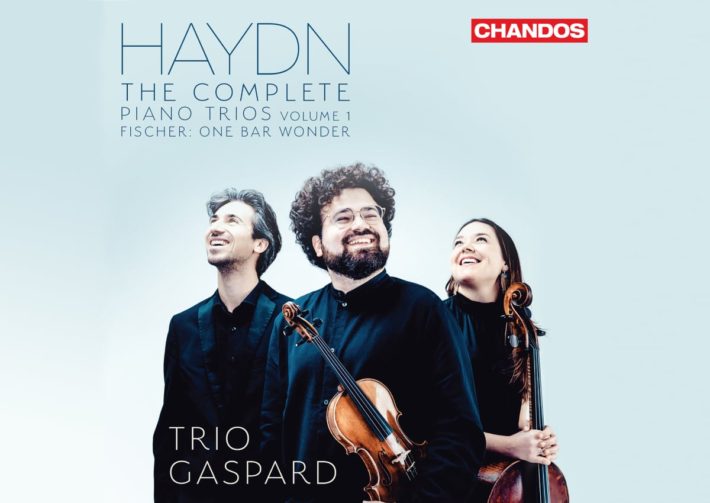Trio Gaspard’s new album marks the beginning of their ambitious complete Haydn piano trio cycle. Not many have attempted this large-scale project, though precedents include the Beaux Arts Trio (who recorded them from 1970-1978) and a period recording by the Van Swieten Trio. This volume’s final trio (Hob. XV: 7) pairs with a contemporary “remix” by Johann Julian Fischer (b. 1981) titled ‘One Bar Wonder’.
The selections don’t follow a numerical or chronological order, explained by the group as an aim to create a more unique arrangement fueled by experiences from their live performance programming. As far as critical editions go, Haydn’s original source material gives way to numerous possible readings, and the group has chosen to use the Henle Urtext.
The sprightly Allegro Moderato of the A Major Trio (Hob. XV: 18) shows each member of the ensemble creating clean lines that sync well. The idiomatic elegance, too, is preserved with some lovely shades of piano and a forte that is full but in no way heavy. In the Andante (track 3), the switch between melodic and accompanimental roles within each instrument is seamless and drives an engaging conversation between all parts. The middle A-major section radiates warmth; violinist Jonian Kadesha lends expressive arcs to his phrases that complement his resonant sound. An interesting note here is how tempo can vastly alter interpretation. The Beaux Art trio’s version is a good minute-and-a-half slower but what we get is an Andante of a much more mournful character. I did find more sensitivity in this interpretation: each small group of notes in the piano is outlined thoughtfully, allowing listeners a better chance to take in the mellow tone. Meanwhile, the expressive phrasing in the strings lends an almost vocal quality to the lines.
The D Major Trio (Hob XV: 24) takes the buoyancy up a notch from the prior selection. What I liked in the opening movement (track 4) was how the ensemble pays attention to the interesting harmonic shifts Haydn includes: listen, for instance, to how the sunny D major transforms into a more pastel yet still playful F major at 0:53 before the A major second theme (1:20) arrives with with a demure character. I would have loved to hear more of the piano’s presence in the final Allegro ma dolce (track 6), which sounds somewhat weak against the strings (maybe an issue of sound balance rather than performer). The contrast the ensemble derives throughout, however, is nice: the major-key sections muse and meander in an unassuming fashion, which sets us up for a surprise with the arrival of the minor. Peppery staccatos in the violin and piano drive the energy, and the cello is not to be relegated to a standby presence, either–Vashti Hunter’s effective downbows add depth and a certain insistence to the accents.
Related Posts
- Review: Haydn – String Quartets Op. 76 – Chiaroscuro Quartet
- Review: Schumann – Complete Piano Trios, Piano Quartet, Piano Quintet – Trio Wanderer
- Review: Beethoven – Piano Trios – Renaud and Gautier Capuçon, Frank Braley
I found the two-movement E-flat Major Trio (Hob. XV: 10) a little less convincing. While the Allegro moderato (track 10) exudes a fitting cheeriness, it feels a little uniform in character. The account from Isaac Stern/Eugene Istomin/Leonard Rose delivers much more nuance and personality right from the start: Istomin especially brings more perspective in the piano’s range of articulation and color. Trio Gaspard’s Presto (track 11) could also use more variation, especially where phrases repeat.
To say that the liner notes are plentiful is an understatement: Marc Vignal’s musical analyses are fairly technical and some familiarity with music theory might help to fully appreciate what’s shared. Trio Gaspard’s own notes are not perfunctory by any means but instead provide extensive and meaningful reflections on editions, their choice to use modern instruments, and even separate sections devoted to Haydn’s treatment of basslines and upper voices. As for the sound engineering, it really misses the mark: balance issues make the piano sound far away and the cello too “boomy,” sometimes giving the impression that the recording takes place in a practice studio.
In sum, Trio Gaspard is off to a decent start, though each work could use more facets of uniqueness to truly stand out even within the parameters of Haydn’s refined style. Perhaps this is something that the ensemble will continue to explore and develop as it continues along its journey.

Haydn – Piano Trios Volume 1
Trio Gaspard
Chandos, CD CHAN20244
Recommended Comparisons
Read more classical music reviews or visit The Classic Review Amazon store
Follow Us and Comment:
[wd_hustle id=”HustlePostEmbed” type=”embedded”]











